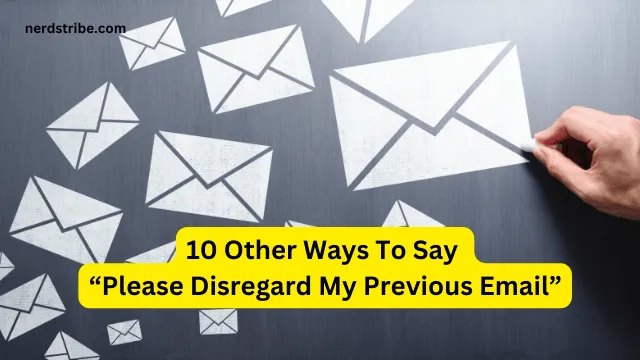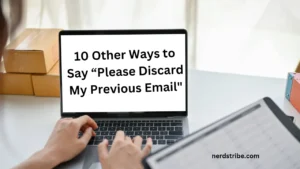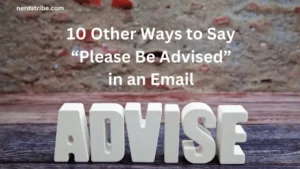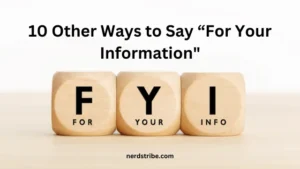We’ve all been there. You send an email, and moments later, realize you made a mistake. Whether it’s a typo, an outdated piece of information, or an incomplete message, the need to retract or correct yourself is inevitable. The standard phrase “Please disregard my previous email” has been used countless times, but is it the best way to address the situation? The way you phrase a retraction can set the tone for how the recipient perceives your communication and professionalism.
Using a variety of phrases to address such situations not only helps maintain clarity but also adds a level of politeness and consideration. You don’t want to sound robotic or too formal, nor do you want to seem careless. A carefully worded message can help you recover smoothly while maintaining professionalism. After all, mistakes happen, but it’s how you address them that matters.
In this blog post, we’ll explore 10 other ways to say “Please disregard my previous email”. These alternatives will help you communicate more effectively and add some variety to your retractions, so you’re prepared the next time you need to send a correction.
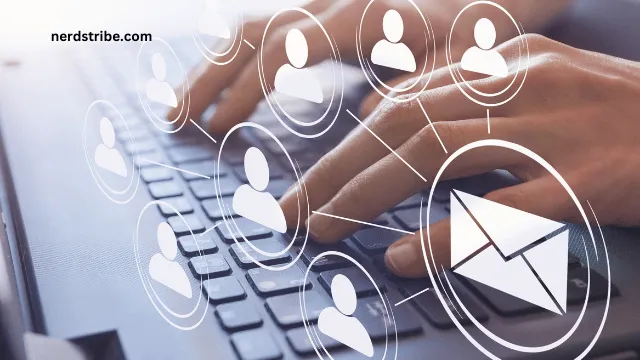
Contents
- 1 1. “Apologies for the Confusion in My Last Email”
- 2 2. “Kindly Ignore My Last Message”
- 3 3. “Please Ignore the Previous Communication”
- 4 4. “Forget About My Earlier Email, Here’s the Correct Info”
- 5 5. “I Made a Mistake in My Last Email”
- 6 6. “Disregard My Previous Message, It Was Sent in Error”
- 7 7. “I Sent the Wrong Information Earlier”
- 8 8. “Please See the Updated Information Below”
- 9 9. “I Would Like to Clarify the Information from My Last Email”
- 10 10. “Please Disregard the Previous Email, and Accept My Apologies”
- 11 Conclusion
- 12 FAQs
- 12.1 When should I use “Forget About My Earlier Email”?
- 12.2 Is “Disregard My Previous Message” too blunt?
- 12.3 What’s the best option for formal emails?
- 12.4 How do I address a more complex mistake?
- 12.5 Should I always apologize when correcting an email?
- 12.6 Can these alternatives be used in all types of emails?
- 12.7
1. “Apologies for the Confusion in My Last Email”
This approach acknowledges the mistake while offering an apology.
- Example: “Apologies for the confusion in my last email, please refer to this updated version.”
- Why It Works: It takes responsibility for the confusion and clears up any misunderstandings.
2. “Kindly Ignore My Last Message”
A more polite and straightforward way to request the recipient ignore the previous email.
- Example: “Kindly ignore my last message and disregard the information provided.”
- Why It Works: Simple and polite, with a respectful tone.
3. “Please Ignore the Previous Communication”
A formal and neutral option for professional settings.
- Example: “Please ignore the previous communication, as I’ve provided updated details below.”
- Why It Works: Direct and formal, suitable for business or corporate environments.
4. “Forget About My Earlier Email, Here’s the Correct Info”
Casual yet clear, this phrase invites the recipient to forget and read the new information.
- Example: “Forget about my earlier email, here’s the correct info you need.”
- Why It Works: It’s direct and immediately presents the correct information.
5. “I Made a Mistake in My Last Email”
This phrase takes full accountability for the error while remaining clear.
- Example: “I made a mistake in my last email, please refer to the corrected details below.”
- Why It Works: By admitting the mistake directly, it shows honesty and openness.

6. “Disregard My Previous Message, It Was Sent in Error”
This option emphasizes that the original message was sent by mistake.
- Example: “Disregard my previous message, it was sent in error. The correct details are below.”
- Why It Works: It clarifies the mistake was unintentional, offering reassurance.
7. “I Sent the Wrong Information Earlier”
This phrase helps the recipient understand that the earlier message contained inaccurate details.
- Example: “I sent the wrong information earlier, please see the accurate details below.”
- Why It Works: It clarifies the error in a direct and friendly way.
8. “Please See the Updated Information Below”
Instead of outright saying to disregard the previous email, this phrase leads with the corrected version.
- Example: “Please see the updated information below, as the prior email had incorrect details.”
- Why It Works: It gently encourages the recipient to pay attention to the new information.
9. “I Would Like to Clarify the Information from My Last Email”
This phrase softens the correction, making it sound less abrupt.
- Example: “I would like to clarify the information from my last email, please see the updated details.”
- Why It Works: It offers a correction in a thoughtful, explanatory manner.
10. “Please Disregard the Previous Email, and Accept My Apologies”
An option that combines both the retraction and an apology.
- Example: “Please disregard the previous email, and accept my apologies for the confusion.”
- Why It Works: It acknowledges the mistake and offers an apology, which helps maintain good relations.
Conclusion
When mistakes happen in email communication, how you address them can make a significant difference. Instead of resorting to the same old “Please disregard my previous email,” these 10 alternatives give you a variety of ways to communicate the correction more thoughtfully.
Whether you need to clarify a detail, offer an apology, or simply correct a misstep, these phrases help convey professionalism while making sure the right message gets across.
By mixing up your retraction phrases, you not only avoid sounding repetitive, but also communicate your message in a way that’s both clear and considerate. It’s important to handle mistakes with grace, and the right wording can turn a potential misstep into an opportunity for effective communication. So the next time you need to send a correction, use one of these alternatives to ensure your message is both clear and polite.
FAQs
When should I use “Forget About My Earlier Email”?
This is best used in informal or casual situations, where clarity and conciseness are key.
Is “Disregard My Previous Message” too blunt?
No, it’s a straightforward and neutral way to address the situation, particularly in professional settings.
What’s the best option for formal emails?
“Please ignore the previous communication” or “Disregard my previous message, it was sent in error” work best in formal emails.
How do I address a more complex mistake?
If the mistake is significant, using a phrase like “I would like to clarify the information from my last email” would be most appropriate.
Should I always apologize when correcting an email?
Apologizing is polite, but not always necessary unless the error caused confusion or inconvenience.
Can these alternatives be used in all types of emails?
Yes, these alternatives can work in a variety of emails, but make sure to choose one that matches the tone of your communication.

